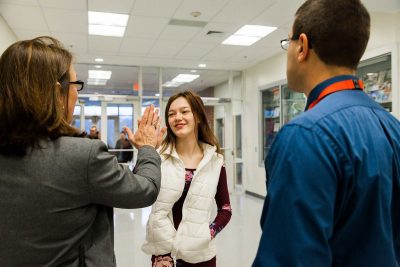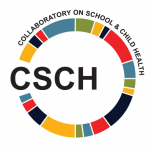Editor’s Note: The following is an excerpt from the UConn Collaboratory on School and Child Health (CSCH)’s recent report titled “Responding to COVID-19: Simple Strategies Anyone Can Use to Foster an Emotionally Safe School Environment.” Board of Trustees Distinguished Professor Sandra Chafouleas serves as co-director of the Collaboratory, while her co-authors include partners (and Neag School alumni) from the Child Health and Development Institute and EASTCONN. Access the full report in PDF format.
Schools play a critical role in fostering emotional safety for adults and students. In responding to COVID-19, schools planning to reopen must include efforts that define a safe school environment as having not only physical elements such as cleaning practices, ventilation conditions, and physical distancing protocols, but also emotional elements.

Creating an emotionally safe environment for reopening schools is especially urgent as many students, and the adults who care for them, are experiencing increased mental health concerns or are exposed to trauma as a result of the nation’s double pandemic of COVID-19 and the confrontation of systemic racism.
To foster an emotionally safe environment, every school administrator, teacher, and staff member must have the necessary knowledge, skills, and attitudes to implement strategies that strengthen the core of an emotionally safe school environment.
Some of these strategies – known as “kernels” – can be simple and cost-efficient, and may be integrated easily within any daily routine. In addition, these strategies, which are based on evidence from research findings, can serve everyone in the school community – from students and their families to teachers and staff.
Simple Strategies for an Emotionally Safe School Environment
Physiological Kernels
-
Aerobic play or behavior
Among the benefits of daily physical activity, including individual or group cardio exercise and sports, are reducing depression and stress hormones, and possible increase of cognitive function. Teachers might find ways to incorporate physical activity into classroom instruction, or provide families with examples of games and exercises that adults and their children can engage in at home.
Example Resources: Fit to Learn Tip Sheet; Teachers Take 5
-
Positive greetings
Frequent, friendly verbal (e.g., saying ‘hello’) or physical (e.g., elbow bump, wave) can improve perceptions of safety and stem aggression or hostility. Teachers might consider giving a positive greeting to students at the door as they enter the classroom each day.
Example Resources: Positive Greetings at the Door
Coping Kernels
-
Self-monitoring
Inviting individual students and adults to evaluate their own behavior and measure their performance compared to a personal goal can lead to increased school achievement for students and reductions in alcohol and tobacco use for adults. Younger schoolchildren might rate their own behavior using a picture; older students could decide on a behavior they would like to target, select a method for measuring it (e.g., rating scale) as well as a timeframe (e.g., during study hall). 
Example Resources: Track Positive Reinforcement With the Be+ App; Teach Students to Change Behavior Through Self-Monitoring
-
Nasal breathing
Breathing deeply through the nose instead of through the mouth can help reduce panic and anxiety and may improve cognitive function, too. Teachers could find several short periods of time per day to guide students in practicing breathing techniques, and families could follow a script or video together with their children at home.
Example Resources: How to Reduce Stress With the 2:1 Breathing Technique (VIDEO); Getting Mindful About Breathing
-
Progressive muscle relaxation
Taking a moment to slowly relax a series of muscles can aid in lowering anxiety, panic, and fear. School staff may benefit from a physical demonstration or video on how to use this technique, and brainstorm times throughout the day when they might be able to use it. Students could take part in such exercises as a class or in small groups, or encouraged to practice outside of class.
Example Resources: Reduce Stress Through Progressive Muscle Relaxation (VIDEO)
Kernels to Increase Positive Response
-
Verbal praise
Individuals who receive specific and positive feedback about their behavior is shown to lead to increased cooperation, academic engagement, and social competence. School administrators, teachers, and parents can tailor such positive messages to students as well as one another.
Example Resources: 10 Simple Ways for Principals to Show Teachers Appreciation
-
Peer-to-peer written praise
Giving a positive ‘shoutout’ to peers that are then shared with the larger group can similarly result in improved social competence, academic achievement, and even physical health. For instance, teachers can have students write something nice about the person sitting in front of them.
Example Resources: Staff Appreciation Coupons; Positive Peer Reporting
-
Special play
School administrators, teachers, and caregivers interacting with students – without placing demands – can, for example, reduce depressive symptoms. Teachers of young children might let students lead play time or play games with them.
Example Resources: Special Play
Kernels to Decrease Negative Response
-
Low-emotion or “private” reprimands
Corrective feedback that is provided in a calm, neutral tone without threat or intense emotion can reduce disruptions, inattention, and aggression.
Example Resources: Respectful Redirection; Five Strategies Principals Can Use to Give Effective Feedback to Teachers
-
Positive practice
Having students, as well as adults, repeatedly practice engaging in positive behavior can help reduce aggression and noncompliance. For students that have been out of school for an extended period, teaching and practicing daily routines and expectations (e.g.,transitions between classes) is needed. If students do not meet this expectation, ask them to repeat the routine and provide verbal praise when they meet the expectations.
Example Resources: Positive Practice
Learn more and find additional free resources in the Collaboratory’s full report, available in PDF format.
This project was completed in partnership between CSCH, EASTCONN, and the Child Health and Development Institute of Connecticut (CHDI). Collaborating authors include Sandra M. Chafouleas, CSCH Co-Director; Taylor A. Koriakin ’20 Ph.D., Neag School doctoral student and educational and behavioral specialist at EASTCONN; Emily A. Iovino ’15 (ED), ’16 MA, ’20 Ph.D., Neag School alumna and educational and behavioral specialist at EASTCONN; Jeana Bracey, CSCH Steering Committee member and associate vice president of School and Community Initiatives at CHDI; and Helene M. Marcy, CSCH program manager.



